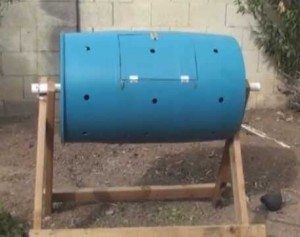There’s no shortage of people who want to show you how to build a compost tumbler, but not all of them have gone about it properly. It’s surprising just how many flawed DIY designs are out there. If you’re going to make your own, it’s because you want good compost yo build great soil. Do your garden a huge favor… engineer it right so you’ve got excellent quality compost ready as fast as possible.
For starters, the size of the barrels most people are using makes them think they can just keep adding fresh waste all year long, and miraculously black gold can get pulled out whenever they need it. No, that’s not how it works. Fill the barrel up first. Composting is a process that will never complete if you keep adding new material. Several smaller barrels makes more sense. You’ll be able to have compost ready faster, and better compost too, when everything in the composter is allowed to break down completely.
 The reason that a compost tumbler is better than just filling up the barrel and letting it set is you have to keep stirring it up. The difference between a rotting mass and composting is oxygen, which in a pile method comes from turning. The barrel makes this easier, but it needs good airflow even when it’s sitting still. Don’t make huge holes! With aeration design like this tumbler on the left, you’ll start loosing the finer particle portions of your compost before it’s done. At least not unless you put screen over larger air holes to protect from losing the little stuff, which is best done with metal barrels and welded in place.
The reason that a compost tumbler is better than just filling up the barrel and letting it set is you have to keep stirring it up. The difference between a rotting mass and composting is oxygen, which in a pile method comes from turning. The barrel makes this easier, but it needs good airflow even when it’s sitting still. Don’t make huge holes! With aeration design like this tumbler on the left, you’ll start loosing the finer particle portions of your compost before it’s done. At least not unless you put screen over larger air holes to protect from losing the little stuff, which is best done with metal barrels and welded in place.
Is plastic better than metal, or just cheaper? If you’ve got a discarded metal barrel on hand, use it. However, they rust, and will need replacing faster than plastic. Metal is also heavier than plastic, but as some enterprising handy guys have done, you can motorize the compost tumbler, and even power them with the sun. But why is this necessary? Like a wheel, the barrel will roll on it’s axle without a huge amount of effort, though if you’re extremely busy or out of town often then this will guard insufficient turning and poor oxygen levels in the pile.
Compost that isn’t stirred enough becomes anaerobic, which will not give you quality compost in the end. In fact, it’s a bad thing to put in your garden soil, which is why one this guy’s design below is one of the best I’ve seen yet. He’s actually added a shredding action that’s super simple, very cheap, and as he says, will improve your compost and speed up the finishing time tremendously.
Notice his aeration holes? They are small – probably 1/4 inch, and the run the full length of the barrel in a continuous row to allow for even airflow from end to end. But I don’t think he has enough holes overall. So many people’s how to guide for making your own rotating composter shows you to put them at both ends, or all in the middle. Bad idea, as is having not enough holes.
Another poor design is not making a door in the side of the barrel. Yes, the lid comes off, but it’s going to be much harder getting compost out once it’s done.
The color of the barrel is also important. You want a dark one, which is why most commercial compost tumblers are dark brown or black – it absorbs the heat of the sun. This keeps temperatures high in your composter for faster composting activity. A white barrel is fine as long as you paint it a dark color. And if the color of the used barrel you can easily obtain is hideous, no worries, a can of spray paint will fix that in a jiffy.
Should you use metal or PVC pipe for your tumbler’s axle? It depends on how big the barrel is. An 80-gallon drum fully loaded with heavy leaves and kitchen waste is too much for PVC, even though the plastic pipe will outlast the metal ones.
Finally, there’s the sun exposure itself. Where you place your composter matters. Like a plant, it’s going to be more energized inside that container with lots of sunshine.